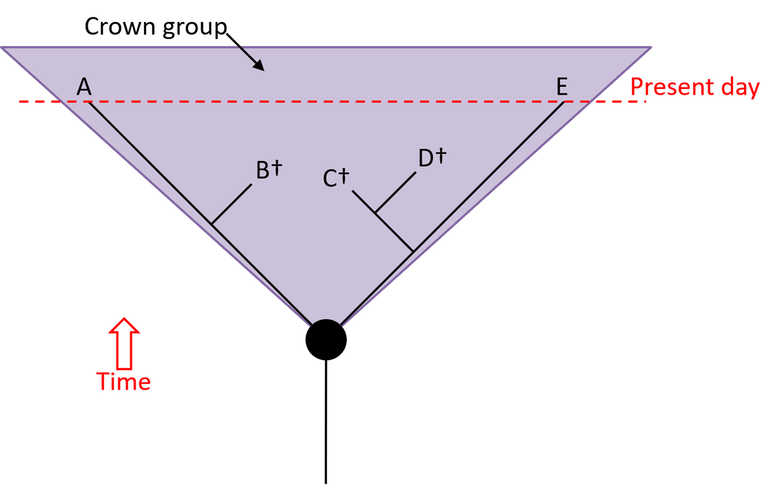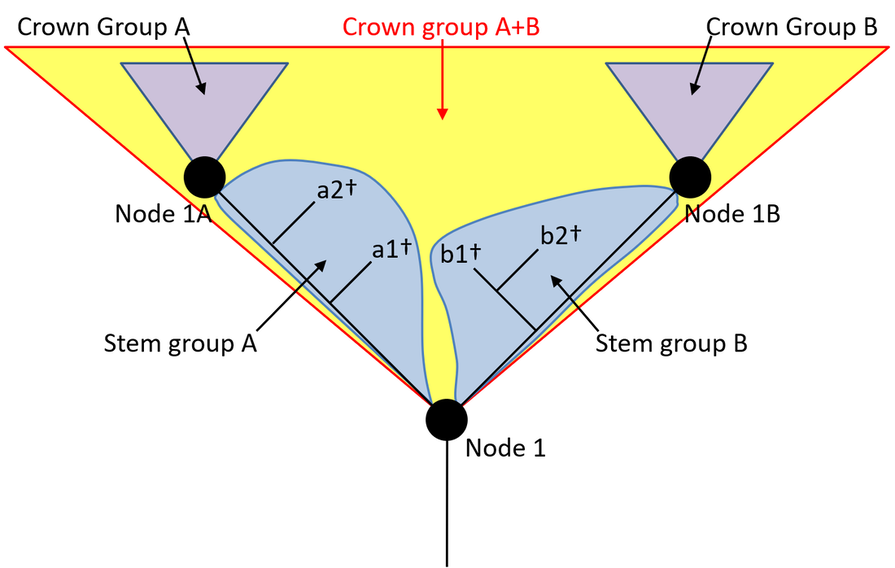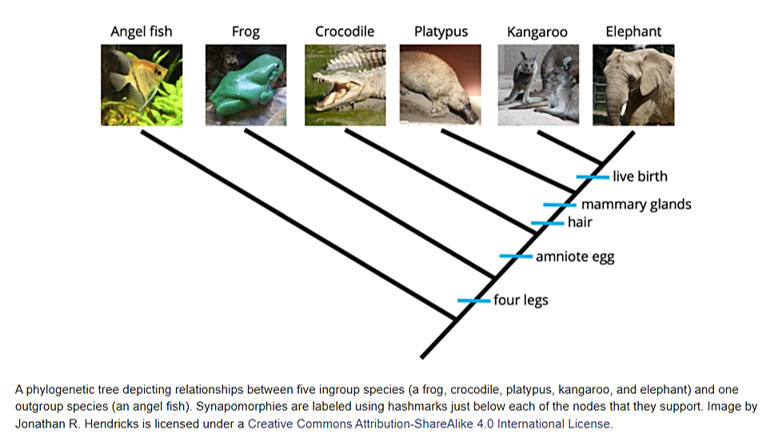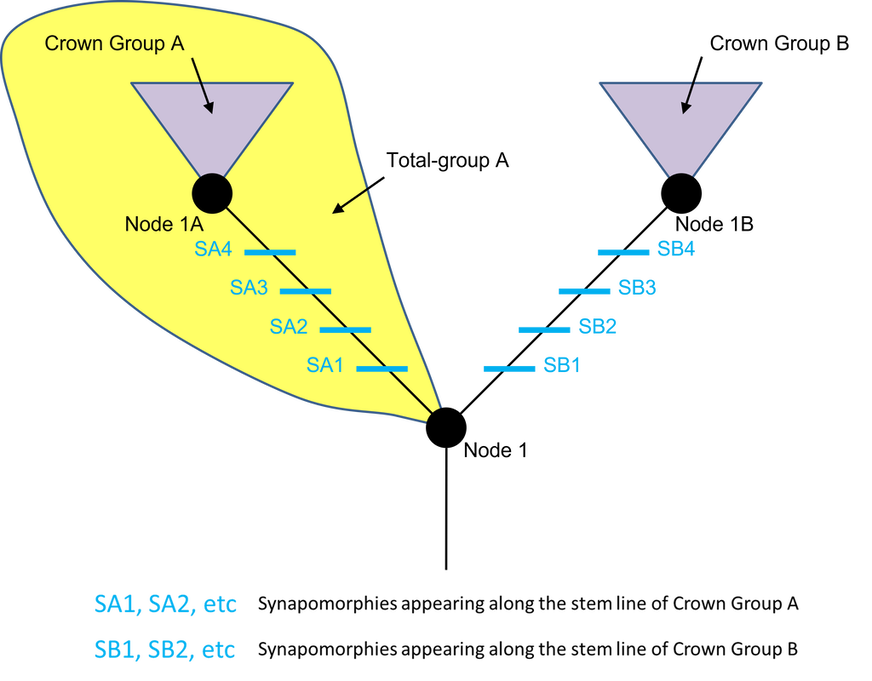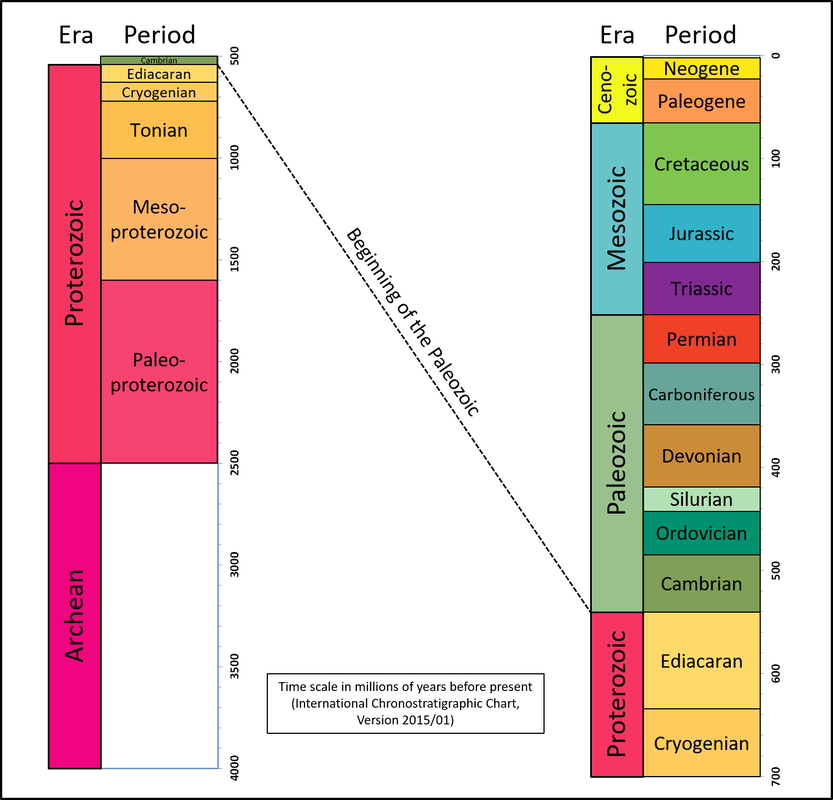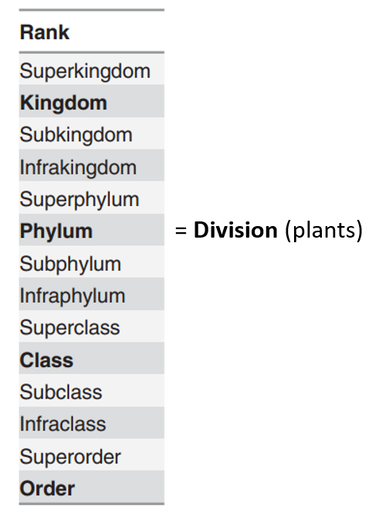The aim of the project presented in this website is to present the transitional fossils that record the evolutionary changes between any group of animals or plants and their ancestors. There are several ways of finding information on any group of interest:
To date, only the vertebrates and land plants have been completed; more will be added as the work is finished.
- From the menu bar above (under the "Evolution of Life" tab or from the "Navigation" tab)
- From highlighted links in individual pages
- Using the search box at the top of every page.
To date, only the vertebrates and land plants have been completed; more will be added as the work is finished.
Approach
The idea of transitional fossils is much misunderstood. The common concept of evolution is that of a single chain representing a linear process; this has given rise to the idea of “missing links” or “transitional fossils”, the absence of which could call into question the validity of the theory of evolution. The chain concept has also engendered objections such as “If humans descended from monkeys, why are there still monkeys?”
These objections are based on a misunderstanding of the evolutionary process. Rather than a single “chain of life”, evolution has generated a tree with a huge number of branches. Thus the evolutionary concept is that of a “tree of life’ in which ancestors give rise to descendants and those descendants in turn generate further descendants, just as in a family tree. According to this view, transitional or intermediate forms only exist as extinct branches of the tree:
These objections are based on a misunderstanding of the evolutionary process. Rather than a single “chain of life”, evolution has generated a tree with a huge number of branches. Thus the evolutionary concept is that of a “tree of life’ in which ancestors give rise to descendants and those descendants in turn generate further descendants, just as in a family tree. According to this view, transitional or intermediate forms only exist as extinct branches of the tree:
Ancestors represent nodes of the tree and are shown as black dots. However, we cannot identify fossils that we know are ancestors in the fossil record; we can only find the fossils that are descended from ancestors. Fossils a and b are extinct descendants of ancestors A and B respectively, while living forms c1 and c2 are descendants of ancestor C. Ancestor B is transitional between ancestor A and ancestor C, but its closest representation in the fossil record is fossil b. Thus fossil b is only an approximate representation of the intermediate ancestor B. If we apply the above diagram to relationships within the archosaurs (crocodiles, dinosaurs and birds), living forms c1 and c2 might represent birds, fossil b could represent dinosaurs, and fossil a could represent extinct crocodiles. However, dinosaurs are only transitional between crocodiles and birds in the sense that they have an ancestor that is intermediate between the ancestors of the crocodiles and the birds. All three groups share a common ancestor, that of all archosaurs.
The tree configuration illustrated above is further developed in the concept of crown and stem groups, ideas critical to an understanding of how evolution is represented in the fossil record. Let us first consider the crown group. In the following figure, the letters A through E represent species that are related to one another; A and E are living at the present day, while B†, C† and D† are extinct. All these species share a last common ancestor (LCA), represented by the black dot:
The tree configuration illustrated above is further developed in the concept of crown and stem groups, ideas critical to an understanding of how evolution is represented in the fossil record. Let us first consider the crown group. In the following figure, the letters A through E represent species that are related to one another; A and E are living at the present day, while B†, C† and D† are extinct. All these species share a last common ancestor (LCA), represented by the black dot:
All of species descended from that LCA, whether extinct or not, comprise the crown group of the living species. Thus the crown group of any taxon, or group of related organisms, is defined as the group that contains the following elements:
With respect to the stem group, we can illustrate the relationships as shown below:
- All living members of the taxon
- The LCA of all those members
- All extinct descendants of the LCA
With respect to the stem group, we can illustrate the relationships as shown below:
The above figure depicts two crown groups A and B, with crown nodes 1A and 1B, respectively. The two crown groups are related and hence share an LCA, represented by node 1. This node is then the crown node of the crown group A + B. Crown groups are thus nested within one another in a hierarchical fashion.
Now the lines that connect crown nodes 1A and 1B to node 1 in the above diagram represent stem lineages. The extinct taxa that branch off those lineages represent the stem groups to crown groups A and B respectively. The stem group corresponding to a particular crown group thus comprises those fossils which are more closely related to that crown group than to any other crown group, but do not fall within the crown group to which the stem group corresponds. The crown and stem groups taken together are known as the total group.
A question that arises at this point concerns how we determine the phylogenetic relationship between fossils. This is done by analysis of the morphological characteristics of the fossils, expressed as “characters”. Fossils that are descended from a common ancestor share with that ancestor derived traits known as synapomorphies (a derived trait is an evolutionary novelty that pertains to the last common ancestor of the descendants under consideration and not to more distant ancestors). The concept is illustrated below:
Now the lines that connect crown nodes 1A and 1B to node 1 in the above diagram represent stem lineages. The extinct taxa that branch off those lineages represent the stem groups to crown groups A and B respectively. The stem group corresponding to a particular crown group thus comprises those fossils which are more closely related to that crown group than to any other crown group, but do not fall within the crown group to which the stem group corresponds. The crown and stem groups taken together are known as the total group.
A question that arises at this point concerns how we determine the phylogenetic relationship between fossils. This is done by analysis of the morphological characteristics of the fossils, expressed as “characters”. Fossils that are descended from a common ancestor share with that ancestor derived traits known as synapomorphies (a derived trait is an evolutionary novelty that pertains to the last common ancestor of the descendants under consideration and not to more distant ancestors). The concept is illustrated below:
During the early stage of development of the two stem lines that separate at the crown node, the two groups are very alike and have few distinguishing synapomorphies. However, as the stem lines diverge, more distinct synapomorphies appear. The fossils that appear along each stem line may thus be considered as transitional fossils.
The process whereby synapomorphies appear along the stem line continues until the line splits by cladogenesis into two new stem lines at the crown node. All of those synapomorphies are then representative of the last common ancestor (LCA) of the new crown group. However, given that they are evolutionary novelties that appear progressively along the stem line, they also occur in some, but not all, fossils of the stem group and are thus not confined to the crown group. The best way to consider the synapomorphies is to think of them as pertaining to the total group, although it is important to understand that while any one of the synapomorphies is a criterion that defines the total group, not all fossils in the total group will share all of the synapomorphies, as illustrated in the figure below:
The process whereby synapomorphies appear along the stem line continues until the line splits by cladogenesis into two new stem lines at the crown node. All of those synapomorphies are then representative of the last common ancestor (LCA) of the new crown group. However, given that they are evolutionary novelties that appear progressively along the stem line, they also occur in some, but not all, fossils of the stem group and are thus not confined to the crown group. The best way to consider the synapomorphies is to think of them as pertaining to the total group, although it is important to understand that while any one of the synapomorphies is a criterion that defines the total group, not all fossils in the total group will share all of the synapomorphies, as illustrated in the figure below:
The approach followed in this website is to track the progress of evolution by reviewing the morphological changes displayed by the transitional fossils associated with each successive stem group. However, this review will be done in a gross, visible sense without entering into morphological details that are difficult to understand without specialist biological or paleontological training. Synapomorphies are typically defined at that detailed level, and so will generally not be discussed in depth in this website. Basic information about each fossil considered will be available in the Data section of the website.
In some cases the morphologically-based interpretations of the kind shown here are inconsistent with molecular (DNA) analysis of the living descendants of the fossils in question; some published phylogenetic trees are based on an integration of the two methods (Hillis, 1987; Hermsen and Hendricks, 2008).
A final idea that we need to discuss before moving on is that of monophyly and paraphyly. A taxon is monophyletic if it shares an LCA and contains all the descendants of that LCA. Thus crown groups and clades are by definition monophyletic. A paraphyletic group, on the other hand, contains the LCA of the group and some, but not all, of the descendants of that LCA. This means that stem groups are by definition paraphyletic.
In some cases the morphologically-based interpretations of the kind shown here are inconsistent with molecular (DNA) analysis of the living descendants of the fossils in question; some published phylogenetic trees are based on an integration of the two methods (Hillis, 1987; Hermsen and Hendricks, 2008).
A final idea that we need to discuss before moving on is that of monophyly and paraphyly. A taxon is monophyletic if it shares an LCA and contains all the descendants of that LCA. Thus crown groups and clades are by definition monophyletic. A paraphyletic group, on the other hand, contains the LCA of the group and some, but not all, of the descendants of that LCA. This means that stem groups are by definition paraphyletic.
Time scale
The ages of rocks, in millions of years, quoted in this website correspond to the geological time scale of version 2015/01 of the International Chronostratigraphic Chart produced by the International Commission on Stratigraphy. A summary of this chart is shown below:
Assumptions
- Evolutionary relationships for which there is no unresolved disagreement in the literature represent the best available scientific consensus. Note that the website contains no independent assessment of evolutionary relationships between or within taxa.
- With respect to the use of Linnaean hierarchical classification of organisms, the system used throughout this website is generally that of Ruggiero et al (2015). Their hierarchy is summarized as follows:
- In general, this website will consider evolutionary changes only at hierarchical levels higher than the order. Only in exceptional cases will evolution within an order be discussed.
Additional information
- Files containing detailed fossil data can be found here or in the site navigation menu under "Data" .
- Attributions, with source and license information, for all images used on each page of this website are given at the bottom of the page in question.
References
Hermsen, E. J., & Hendricks, J. R. (2008). W (h) ither fossils? Studying morphological character evolution in the age of molecular sequences. Annals of the Missouri Botanical Garden, 95(1), 72-100.
Hillis, D. M. (1987). Molecular versus morphological approaches to systematics. Annual review of Ecology and Systematics, 18(1), 23-42.
Ruggiero, M. A., Gordon, D. P., Orrell, T. M., Bailly, N., Bourgoin, T., Brusca, R. C., ... & Kirk, P. M. (2015). A higher level classification of all living organisms. PloS one, 10(4), e0119248.
Hillis, D. M. (1987). Molecular versus morphological approaches to systematics. Annual review of Ecology and Systematics, 18(1), 23-42.
Ruggiero, M. A., Gordon, D. P., Orrell, T. M., Bailly, N., Bourgoin, T., Brusca, R. C., ... & Kirk, P. M. (2015). A higher level classification of all living organisms. PloS one, 10(4), e0119248.
Photo credit
Header: By Wolfgang Sauber (Own work) [GFDL (http://www.gnu.org/copyleft/fdl.html) or CC BY-SA 3.0 (https://creativecommons.org/licenses/by-sa/3.0)], via Wikimedia Commons
Header: By Wolfgang Sauber (Own work) [GFDL (http://www.gnu.org/copyleft/fdl.html) or CC BY-SA 3.0 (https://creativecommons.org/licenses/by-sa/3.0)], via Wikimedia Commons

